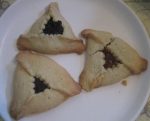When Eastern Europeans immigrated to America, they brought their hamantashen recipes with them. (photo from Infrogmation via Wikimedia Commons)
When it comes to Purim pastries, hamantashen are what most of us think of first. The word is taken from the German mohn, meaning poppy seeds, and taschen, referring to pockets. Some say the pockets refer to Haman, who stuffed his pockets with bribe money.
The original name, mohntaschen, and the tradition of eating them, may date back as far as the 12th century. Israeli historian, caterer and cook Shmil Holland says that, when Jews fled Germany for Eastern Europe in the late Middle Ages, they took the poppy seed pastry with them and added the Yiddish prefix ha, thus making it hamantash.
In the Encyclopedia of Jewish Food, Gil Marks (z”l) writes that Eastern Europeans and their foods came to dominate the Ashkenazi world in the 19th century, and “hamantashen emerged as the quintessential Ashkenazic Purim treat.” The original dough was kuchen, a rich yeast dough, and common fillings include poppy seeds, chocolate, prunes or other fruit fillings. When Eastern Europeans immigrated to America in the late 19th and early 20th centuries, the idea came with them.
(An aside: In 18th-century Bohemia, Jews added a prune filling. The story is that a local merchant was accused of selling poisoned plum jam; when he was cleared of the charges, his family marked the occasion as a holiday, called povidl Purim, or plum jam Purim.)
In addition to the pocket imagery, several other explanations have been suggested for the triangular shape of hamantashen. Some say they represent a triangular-shaped hat worn by Haman, the villain in the Purim story, and that we eat them as a reminder that his cruel plot was foiled. Others say they represent Esther’s strength and the three founders of Judaism: Abraham, Isaac and Jacob, as a midrash says that, while reflecting on his plan to get rid of the Jews, Haman realized the three Patriarchs would intercede.
Yet another explanation lies in the cookies’ name in Israel, oznei Haman, Haman’s ears – perhaps referencing an old custom of cutting off the ears of criminals before they were executed. When the resulting treat became known as Haman’s ears for Purim is unknown, although it is mentioned as early as 1550. However, according to Marks, historical oznei Haman were strips of dough fried in honey or sugar syrup – a 13th-century Andalusian cookbook has a recipe for this “ear” dish and it was adopted by Sephardim.
Whatever their name, the reason behind eating hamantashen remains the same: remembering how close the Jewish people came to tragedy and celebrating the fact that they escaped death.
Here are some recipes from my family for your own celebration of Purim, which starts this year on March 12. My grandmother (z”l) made the most beautiful-looking yeast hamantashen.
GRANDMA’S PRUNE FILLING
1 1/2 cups finely cut prunes
1/4 cup sugar
2 tsp lemon juice
- Place prunes in a saucepan with water to cover. Bring to a boil then reduce heat and simmer until soft.
- Mash prunes, add sugar and lemon juice.
GRANDMA’S POPPY SEED FILLING
1 cup ground poppy seeds
1/4 cup milk or water
2 tbsp butter or margarine
1/2 cup raisins
1/2 cup finely chopped nuts
2 tbsp honey
1 tsp vanilla
- Place poppy seeds, milk or water, butter or margarine, raisins, nuts and honey in a saucepan. Bring to a boil, then reduce heat and simmer until milk or water is absorbed.
- Add vanilla.
GRANDMA’S YEAST HAMANTASHEN
4 tsp dry yeast
1/2 cup lukewarm milk
2 eggs
1/2 cup sugar
1/2 cup butter or margarine
1 tsp salt
1 cup sour cream
4-5 cups flour
vegetable oil
Day before baking:
- Dissolve yeast in a bowl with warm milk. Let stand.
- Beat eggs and sugar in a bowl. Add yeast mixture, butter or margarine, salt and sour cream and blend well.
- Add four cups flour and mix thoroughly. Gradually add the rest of the flour and knead until the dough is smooth and does not stick to your hands.
- Grease a large mixing bowl and add the dough. Turn the dough until it is covered with the oil. Cover with a cloth and refrigerate overnight.
Next day:
- Preheat oven to 350°F. Grease a cookie sheet.
- Roll out dough on a lightly floured board to 1/4-inch thick.
- Cut into 16 squares. Place a spoonful of filling on each. Fold to form triangles. Place on greased cookie sheet. Let rise one hour until double in size.
- Bake for 20 minutes or until brown.
MOM’S COOKIE HAMANTASHEN
2 eggs
1/2 cup sugar
1/2 cup margarine
2 3/4 cups flour
2 tsp baking powder
1/4 tsp salt
1 tsp vanilla
juice of half an orange or 1/2 cup sour cream
- Preheat oven to 350°F. Grease a cookie sheet.
- In a mixing bowl, blend eggs, sugar and margarine.
- Add flour, baking powder and salt and mix well.
- Add vanilla and orange juice or sour cream and blend into a dough. Refrigerate 20 minutes.
- Roll out dough 1/4-inch thick. Cut into three-inch circles. Place one tablespoon of filling in the centre of each and fold to make a triangle. Place on a cookie sheet and bake for 20-30 minutes.
Sybil Kaplan is a journalist, lecturer, book reviewer and food writer in Jerusalem. She created and leads the weekly English-language Shuk Walks in Machaneh Yehudah, she has compiled and edited nine kosher cookbooks, and is the author of Witness to History: Ten Years as a Woman Journalist in Israel.

